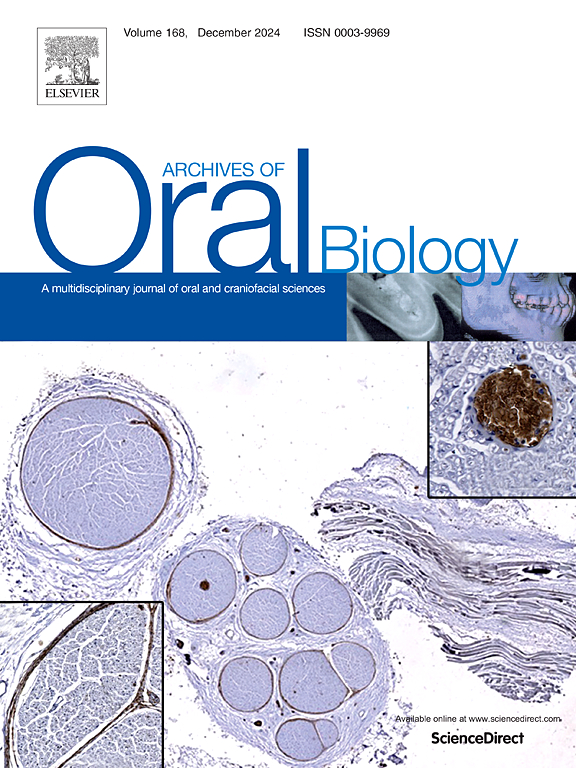结合生物信息学和实验验证确定m1a修饰基因作为牙周炎和糖尿病的潜在诊断生物标志物。
IF 2.1
4区 医学
Q2 DENTISTRY, ORAL SURGERY & MEDICINE
引用次数: 0
摘要
目的:通过生物信息学和实验验证相结合的方法,鉴定具有牙周炎与2型糖尿病(T2DM)诊断潜力的m1a修饰基因。设计:从GEO数据库中整合牙周炎和T2DM患者的转录组学数据,分析m1a相关基因表达。采用岭回归和逻辑回归建立诊断模型。基于m1A评分和患者聚类模型,基因功能富集、免疫浸润和蛋白-蛋白相互作用分析探索了m1A的调控机制。收集牙周炎患者和健康对照者的牙龈组织标本,建立链脲佐菌素诱导的糖尿病β细胞模型。采用qRT-PCR验证候选基因(RRP8、ALKBH3、MAK16和DDX18)。采用非参数Mann-Whitney U检验进行统计比较。结果:几个m1a相关基因在牙周炎和T2DM中均有差异表达。RRP8和ALKBH3具有较高的预测价值,曲线下面积(AUC)值分别为0.80(牙周炎)和0.72 (T2DM)。m1A评分和患者聚类模型有效区分具有不同转录组和免疫谱的患者组。枢纽基因MAK16和DDX18表达模式一致,且与免疫浸润有很强的相关性。qRT-PCR证实了炎症牙龈组织中RRP8、ALKBH3、MAK16和DDX18的显著下调,以及糖尿病细胞模型中的上调(p )。结论:这项综合研究鉴定了关键的ma1修饰基因,可能与牙周炎和糖尿病有关。生物信息学分析和实验验证的结合突出了它们作为诊断性生物标志物的潜力,并为这些共病的共同分子机制提供了新的见解。本文章由计算机程序翻译,如有差异,请以英文原文为准。
Combined bioinformatics and experimental validation identifies m1A-modified genes as potential diagnostic biomarkers in periodontitis and diabetes
Objective
To identify m1A-modified genes with diagnostic potential linking periodontitis and type 2 diabetes mellitus (T2DM) by integrating bioinformatics and experimental validation.
Design
Transcriptomic data for periodontitis and T2DM patients were integrated from the GEO database to analyze m1A-related gene expression. A diagnostic model was constructed using ridge and logistic regression. Gene function enrichment, immune infiltration, and protein-protein interaction analyses explored m1A regulatory mechanisms based on m1A scoring and patient clustering models. Gingival tissue samples were collected from periodontitis patients and healthy controls, and a streptozotocin-induced diabetic β-cell model was established. qRT-PCR was performed to validate candidate genes (RRP8, ALKBH3, MAK16, and DDX18). Statistical comparisons were conducted using the non-parametric Mann–Whitney U test.
Results
Several m1A-related genes were differentially expressed in both periodontitis and T2DM. RRP8 and ALKBH3 had high predictive value, with area under the curve (AUC) values of 0.80 (periodontitis) and 0.72 (T2DM). m1A scoring and patient clustering models effectively distinguished patient groups with distinct transcriptomic and immune profiles. Hub genes MAK16 and DDX18 showed consistent expression patterns and strong correlations with immune infiltration. qRT-PCR confirmed significant downregulation of RRP8, ALKBH3, MAK16, and DDX18 in inflamed gingival tissues, and upregulation in the diabetic cell model (p < 0.05), supporting the bioinformatics findings.
Conclusions
This integrative study identifies key m1A-modified genes potentially linking periodontitis and diabetes. The combination of bioinformatics analysis and experimental validation highlights their potential as diagnostic biomarkers and provides novel insights into shared molecular mechanisms of these comorbid conditions.
求助全文
通过发布文献求助,成功后即可免费获取论文全文。
去求助
来源期刊

Archives of oral biology
医学-牙科与口腔外科
CiteScore
5.10
自引率
3.30%
发文量
177
审稿时长
26 days
期刊介绍:
Archives of Oral Biology is an international journal which aims to publish papers of the highest scientific quality in the oral and craniofacial sciences. The journal is particularly interested in research which advances knowledge in the mechanisms of craniofacial development and disease, including:
Cell and molecular biology
Molecular genetics
Immunology
Pathogenesis
Cellular microbiology
Embryology
Syndromology
Forensic dentistry
 求助内容:
求助内容: 应助结果提醒方式:
应助结果提醒方式:


